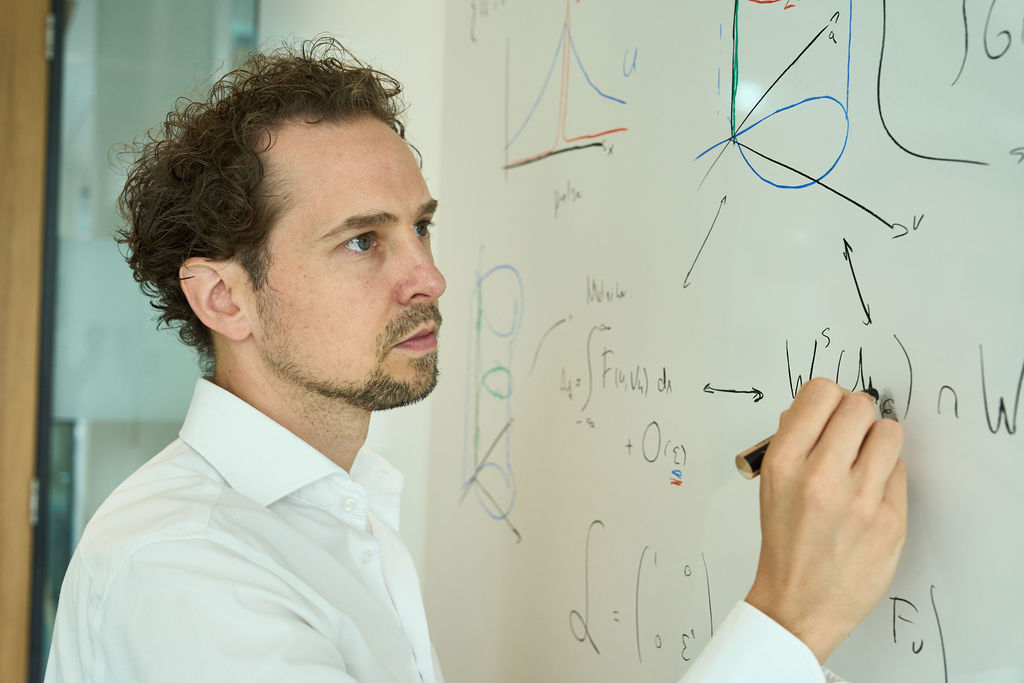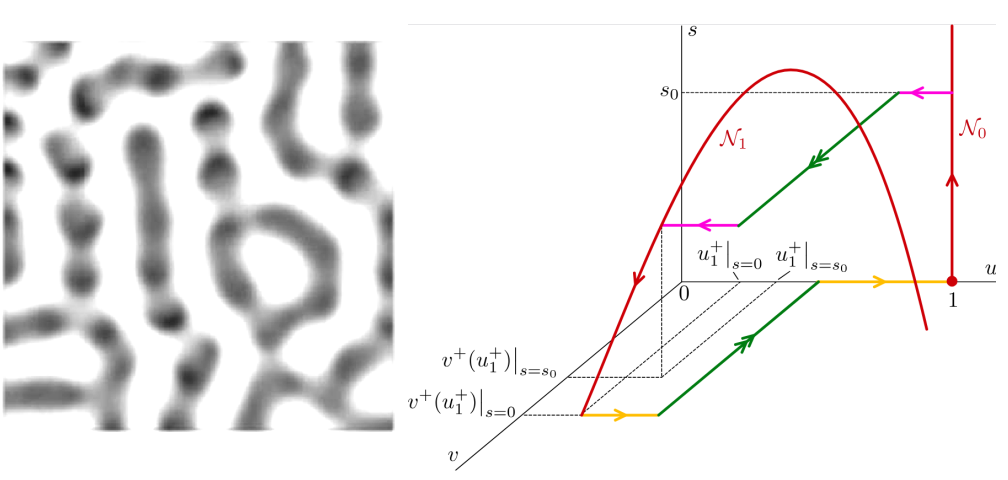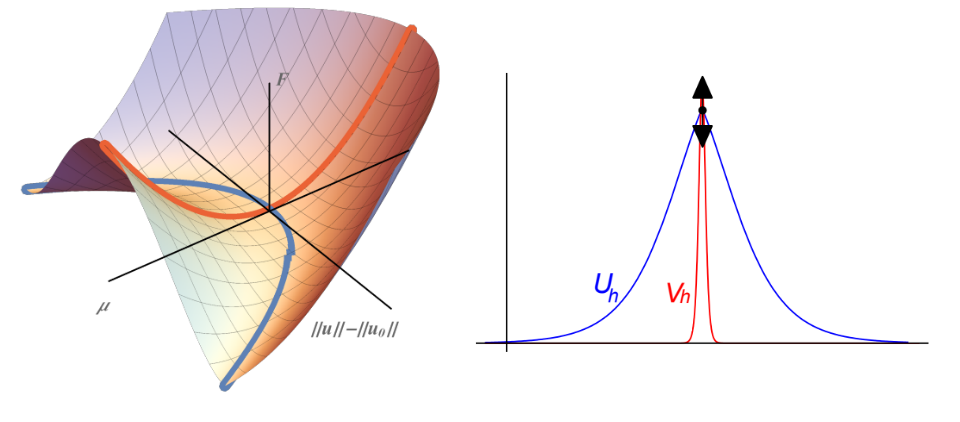
My research focuses on the analysis of patterns that occur in nature.
I use techniques and ideas from the theory of dynamical systems to study the emergence, existence, stability and dynamics of pattern-type solutions in systems of nonlinear partial differential equations, such as reaction-diffusion systems.
Combining singular perturbations with geometric methods, I use analytical techniques to study the dynamics and interaction of patterns patterns in general classes of models, on curved and dynamical manifolds or spatially heterogeneous backgrounds.
I'm inspired by pattern phenomena in biology, from subcellular to ecological scales. A major part of my work is developed in close collaboration with mathematical biologists, including interdisciplinary work with ecologists and cell biologists.
Research themes
Patterns on curved surfaces
How does the shape of a surface influence patterns on that surface? And what happens when a pattern determines the shape of the surface, creating a dynamical interaction? Mechanochemical pattern formation addresses these questions. Using geometrical and analytical methods, we can try to understand how patterns form on dynamically evolving backgrounds.
My main collaborators on this theme are Daphne Nesenberend (Leiden), Anna Marciniak-Czochra and Moritz Mercker (Heidelberg).


Multiple scale patterns
Scale separation in space and time is an important feature of many patterns, and of many models that have pattern-type solutions. Mathematically, we can use the theory of singular perturbations to study the hierarchy of scales in models, and describe the occurrence of spatial structures on multiple scales. We develop and apply these ideas in the context of cell biology, developmental biology and ecology.
My present and past collaborators on this theme include Annalisa Iuorio (Naples), Paul Carter (UCI), Nikola Popovic (Edinburgh) and Arjen Doelman (Leiden).
Controlling pattern stability
Stable patterns can be observed: analysis of pattern stability and dynamics proves an important link between predictions from mathematical models and physical or biological practice. What happens when a pattern becomes unstable, and how can we control its stability? Analytical methods based on scale separation are instrumental in addressing these questions, in particular in nonlinear, multi-component models for pattern formation.
My present and past collaborators on this theme include Isabelle Schneider (Berlin), Björn de Rijk (Karlsruhe) and Keith Promislow (MSU).

Publications
A. Davin, J. von Hardenberg, P.M.J. Berghuis, A.G. Mayor, E. Magazzino, M. Rietkerk, F. Veerman and M. Baudena, Guerilla clonal growth strategy leads to amorphous pattern formation in a drylands vegetation model, submitted (2025) | preprint
M. Chirilus-Bruckner, L. van Vianen and F. Veerman, Travelling front solutions in a spatially heterogenous reaction-diffusion system, submitted (2025) | arXiv
D. Nesenberend, A. Doelman and F. Veerman, Curvature induced patterns: A geometric, analytical approach to understanding a mechanochemical model, submitted (2025) | bioRxiv
G. Grifò, A. Iuorio and F. Veerman, Far-from-equilibrium travelling pulses in sloped semi-arid environments driven by autotoxicity effects, SIAM Journal on Applied Dynamical Systems 85/1 (2025) | doi | arXiv
M. Mercker, A. Tursch, F. Veerman, A. Kazarnikov, S. Höger, T. Lengfeld, S. Özbek, T. Holstein and A. Marciniak-Czochra, Two separate but interconnected pattern systems are required to control body-axis and head-organiser formation, submitted (2024) | bioRxiv
P. Carter, A. Doelman, A. Iuorio and F. Veerman, Travelling pulses on three spatial scales in a Klausmeier-type vegetation-autotoxicity model, Nonlinearity 37/9 (2024) | doi | arXiv
A. Iuorio, M. Baudena, M.B. Eppinga, F. Giannino, M. Rietkerk and F. Veerman, Travelling waves due to negative plant-soil feedbacks in a model including tree life-stages, Mathematical Biosciences 368/109128 (2024) | doi | bioRxiv
A. Iuorio, M.B. Eppinga, M. Baudena, F. Veerman, M. Rietkerk and F. Giannino, Modelling how negative plant-soil feedbacks across life stages affect the spatial patterning of trees, Nature Scientific Reports 13/19128 (2023) | doi | preprint
F. Veerman and I. Schneider, Controlling pulse stability in singularly perturbed reaction-diffusion systems, Chaos 33/083135 (2023) | doi | arXiv
F. Veerman, M. Mercker and A. Marciniak-Czochra, Beyond Turing: Far-from-equilibrium patterns and mechano-chemical feedback, Philosophical Transactions of the Royal Society A 379/2213 (2021) | doi | bioRxiv
A. Iuorio and F. Veerman, The influence of autotoxicity on the dynamics of vegetation spots, Physica D 427/133015 (2021) | doi | bioRxiv
Y. Chen, A. Doelman, K. Promislow and F. Veerman, Robust stability of multicomponent membranes: the role of glycolipids, Archive for Rational Mechanics and Analysis 238/3 (2020) | doi | arXiv
F. Veerman, N. Popović and C. Marr, Parameter inference with analytical propagators for stochastic models of autoregulated gene expression, International Journal of Nonlinear Sciences and Numerical Simulation 23/3-4 (2019) | doi | bioRxiv
A. Doelman, J. Rademacher, B. de Rijk, and F. Veerman, Destabilization mechanisms of periodic pulse patterns near a homoclinic limit, SIAM Journal on Applied Dynamical Systems 17/2 (2018) | doi | pdf
F. Veerman, C. Marr and N. Popović, Time-dependent propagators for stochastic models of gene expression: an analytical method, Journal of Mathematical Biology 77/2 (2018) | doi | pdf
S.H. Piltz, F. Veerman, P.K. Maini, and M.A. Porter, A predator-2 prey fast-slow dynamical system for rapid predator evolution, SIAM Journal on Applied Dynamical Systems 16/1 (2017) | doi | arXiv | pdf
F. Veerman, Breathing pulses in singularly perturbed reaction-diffusion systems, Nonlinearity 28/7 (2015) | doi | pdf
A. Doelman and F. Veerman, An explicit theory for pulses in two component, singularly perturbed, reaction-diffusion equations, Journal of Dynamics and Differential Equations 27/3 (2015) | doi | pdf
F. Veerman, Pulses in singularly perturbed reaction-diffusion systems, 2013 (ISBN 978-90-8891-684-7) | lur | pdf
F. Veerman and A. Doelman, Pulses in a Gierer-Meinhardt equation with a slow nonlinearity, SIAM Journal on Applied Dynamical Systems 12/1 (2013) | doi | pdf
F. Veerman and F. Verhulst, Quasiperiodic phenomena in the Van der Pol-Mathieu equation, Journal of Sound and Vibration 326/1-2 (2009) | doi
Recent talks
VU Amsterdam Dynamics Seminar - Mechanochemical pattern formation
Mathematical modelling of complex biological systems, Messina - Mechanochemical pattern formation
General Mathematics Colloquium, Mathematical Institute, Leiden - A mathematical guide to pattern formation
SIAM Conference on Applications of Dynamical Systems 2025, Denver - The influence of autotoxicity on travelling vegetation spots
Dynamical Systems applied on Biology and Natural Sciences 2025, Naples - Far-from-equilibrium travelling pulses in sloped semi-arid environments driven by autotoxicity effects
Dynamics Days Europe 2024, Bremen - Travelling pulses on three spatial scales in a Klausmeier-type vegetation-autotoxicity model
European Conference on Mathematical and Theoretical Biology 2024, Toledo - Negative feedback driving biodiversity: Transient biomass distributions and the Janzen-Connell hypothesis
Multiple scales: theory and applications, Lorentz Center, Leiden - Noninvasive control of pattern stability in singularly perturbed systems
SIAM Conference on Nonlinear Waves and Coherent Structures 2024, Baltimore - Controlling pattern stability by noninvasive feedback
Equadiff 2024, Karlstad - Travelling fronts between spatially heterogeneous background states: a new approach to a fully spatiotemporal problem
Turing Symposium on Morphogenesis 2024, Sendai - Beyond Turing: far-from-equilibrium patterns in a mechanochemical model
NCTS Webinar on Nonlinear Evolutionary Dynamics, Taiwan - Beyond Turing: controlling pattern stability in reaction-diffusion systems
Applied Analysis Seminar, Institute for Mathematics, Heidelberg - Beyond Turing: controlling pattern stability in reaction-diffusion systems
Modelling Diffusive Systems 2023: theory and biological applications, ICMS, Edinburgh - Mechanochemical pattern formation: far-from-equilibrium patterns on a deforming surface